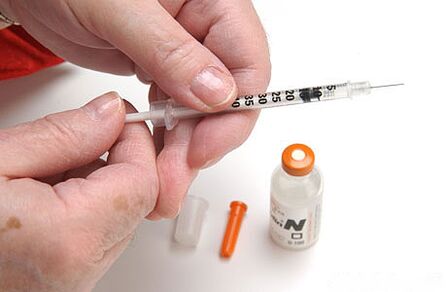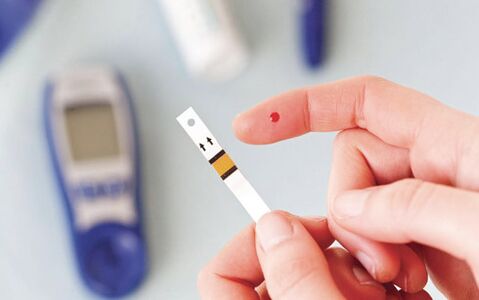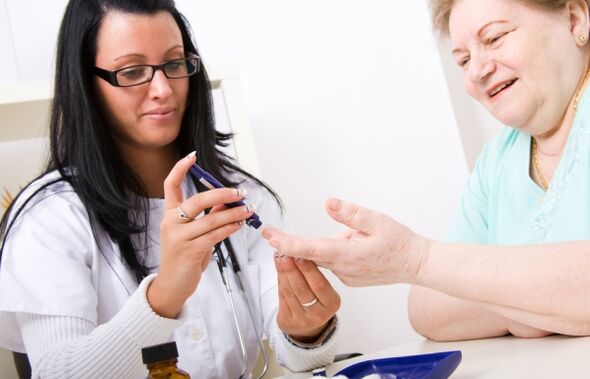
Pathogenesis of the diseaseDiabetes mellitus is a persistent violation of the synthesis of the insulin hormone and its interaction with the tissues in the body.Insulin treats sugar received in glucose and passes through cellular membranes. Thus, the hormone lowers the degree of blood sugar and provides cells with nutrition. Insulin deficiency with a sensitivity to altered tissues leads to the fact that glucose does not participate in metabolism and continues to circulate through the body. The biology not only of the metabolism of carbohydrates is lost, but also fat, proteins, water salt.The ascent of sugar increases the amount of lipid fractions in the blood circulation, which contributes to the development of atherosclerosis. The transformation of glucose into glycogen slows down and the body begins to use fat as resources. The fatty acids decompose and the ketone bodies appear which damage the central nervous system.Causes and currentInsulin production is disrupted due to damage to the synthesis of beta cells. The main risk factor for diabetes is inheritance, which considerably improves the effect of other factors. The probability of getting sick increases with age. The causes of diabetes:The failure of the immune system. Causes the cells to attack with a pancreas with protective proteins.Obesity. Reduces the reaction of hormone receptors due to an excess of adipose tissue (the cause of the type of diabetes type). Pancreatic disease. Call the death of cells secreting the hormone (pancreatitis, cancer).Virus infection (pathogens of chickenpox, rubella, flu).Nervous tension.The disease exists in the role of independent pathology and as a temporary symptom. The causes of diabetes mellitus can be the consequences of errors in the work of endocrine organs (hyperthyroidism, pheochromocytoma). The symptomatic excess of glucose detected during pregnancy (including using IVF) is called gestational diabetes. Hyperglycemia occurs as a side effect of prolonged use of certain drugs (glucocorticoids, estrogens, psychotropic drugs), when exposed to toxic substances.Hyperglycemia signals diabetes only in the presence of insulin errors, the appearance of symptoms of sugar disease.Types of diabetic pathology
Diabetes mellitus constitutes a violation of the metabolism of carbohydrates and water in the body.WHO classification determines two main types of disease: insulin dependents (type I) and the opposite form - diabetes dependent on insulin (type II). They differ due to the appearance and details of pathogenesis, the nature of the course, have their own treatment characteristics, but the consequences are also dangerous.Diabetes dependent on insulin (juvenile) is caused by the autoimmune assault on the body. Assigned endocrine beta cells are unable to produce insulin at the necessary doses, its constant administration from the outside is necessary. People under the age of 30, thin. The disease suddenly begins, progress quickly and has a serious course. Dependent on the insulin. The causes of diabetes of this type are heredity and obesity. Insulin can be produced in sufficient quantities, but cells are not sensitive to it. This is due to an excess of nutrients. Diabetics over 40 have a complete physique. The acquired diabetes is gradually developing, takes place stable. Most patients suffer from this type of disease.SeverityThe severity of the development of diabetes mellitus at the stage of blood sugar, glucosuria, the degree of dysfunction of the target organs, the presence of complications is determined, which shows the compensation capacities of the body. There are 4 degrees of gravity. If diabetes goes to a soft degree, treatment and nutrition are selected correctly. The degree of diabetes and symptoms is described in the table.DegreeBlood sugar, mmol / lUrine readingsSymptoms1st (light)No more than 7The protein is normal, glucosuria is absentAbsent2nd (middle)7-10Glucose up to 40 g / l; Ketosis and ketoacidosis appear periodicallyDysfunctions of cardiac activity, visual devices, nervous system, manifestation of Angioneropathy3rd (heavy)10-14Persistent glucosuria 40 g / l, lots of protein, ketone bodyImproved effect on the organs, a decrease in vision, pain and numbness in the legs, an increase in blood pressure4th (SuperPolate)15-25Over 50 g / l of glucose, intense proteinuria and cretculationSolid defeat of all organs, kidney failure, diabetic coma, gangrene, ulcerative homes on the legs
Diabetes characteristic symptoms
The clinical signs of the disease in most cases are characterized by progressive evolution.Diabetes in adults may not immediately declare that this leads to the development of complications. Type I diabetes develops quickly with high blood sugar and a coma. The intensity of the symptoms of acquired diabetes is associated with the degree of deficiency in insulin products, the individuality of the patient's body. You must go through a test to determine the degree of sweetness of the blood, if one of the symptoms appears:an unusual sensation of dry mouth;The inability to quench the thirst;Improved diuresis - an increase in the amount of urine displayed;rapid weight loss or weight gain;Dressing and dry skin;Reduction in skin sensitivity on the feet;numbness, tingling in the legs and arms;Convulsions, severity of the legs;purulent skin process caused by slow skin regeneration; low resistance to infections;constant feeling of hunger;Vague vision;Increase in blood pressure;swelling of the face and legs;Pain in the head, fainting;Body acetone smell;darkening consciousness;Pseudo-periperitric (false "sharp stomachs").The consequences of blood sugarDiabetes mellitus is an insidious disease. The excess of blood sugar harms in blood vessels causes damage caused by the wall. Excess glucose is transformed into fat deposits. This leads to obesity and steatgepatosis (accumulation of lipids in liver cells). Glucose causes glycolization of membrane proteins. The oxidative process is able to cause an impairment of the functioning of proteins and the appearance of toxic to-product. Defective proteins cause disturbances in the structure of the organs. The accumulation of toxins and ketones causes damage to the nervous system of the patient, to the disorders of the mind and a coma. Excessive blood cholesterol sets up on the arterial walls in damaged areas and forms atherosclerosis plates, contributing to the angiopathies of the eyes, leg vessels and other organs.The degree of excess of the blood sugar level determines the complexity of the course of the disease.The risk of complications
The complicated diabetes mellitus carries the danger of the life of a sick person, so it is so important to identify the disease over time and start treatment. The disease is aggravated for 10 to 15 years. The complications that appear progress quickly and it is not easy to face them. Acute complications with primary diabetes (hypo- and hyperglycemia) are caused by net fluctuations in blood sugar. A list of states that complicate diabetic disease: Hypoglycemia - a clear drop in glucose less than 3 mmol / L can lead to a hypoglycemic coma.Hyperglycemia - lift the sugar indicator greater than 6 mmol / L ends with a hyperglycemic coma.Ketoacidosis - Damage to neurons with ethics, causing someone.Neuropathy - Too bad the nerves of the periphery.Diabetic foot, trophic ulcers and deadlines of the lower limbs caused by angiopathy and neuropathy.Nephropathy - Damage to the kids of the kidneys, which disrupts the functioning of the urinary system.Retinopathy - Lighting of the vascular walls of the retina.Cardiomyopathy - Disorders in heart muscle.Encephalopathy - Pathology in brain vessels.DiagnosisThe diagnosis of diabetes determines the type of disease, severity, the presence of internal organ lesions. Studies can be carried out several times to assess the degree of progress of the disease and the effect of treatment. Diabetes diagnostic criteria are signs characteristic of diabetes and the degree of glucose lifting. To confirm the diagnosis, urine and blood tests, instrumental studies are carried out:Indications of fasting glucose;Glycemic profile (daily vibrations);blood at insulin level;a study of glucose tolerance, the sugar ratio in empty stomach and after the consumption of carbohydrates; Analysis of glycolized hemoglobin;Blood for biochemistry;General analysis of urine detecting glucose, proteins;electrolytic blood test;Acetone indicators in urine;Inspection of eyes view;Rebell test for renal lesions;Ultrasound of the abdomen;cardiogram to check the function of the heart;Capillaryoscopy, the re -area of the lower limbs determines the degree of defects in the vessels.In healthy people, the level of glucose in the blood is around 3, 3 to 5, 5 mmol / L.Disease treatment
In the presence of suspicion of meal diabetes, this diagnosis must be confirmed or refuted.Diabetes mellitus is a chronic pathology which must be treated for life.The principles of diabetes treatment - sugar control in the glumyment of blood circulation and prevention of complications by observing the diet and taking medication.An endocrinologist can treat the disease, a cardiologist, a neuropathologist, an ophthalmologist, a vascular surgeon are linked.Modern treatment methods - drugs, diet, physical education - slow down the progression of the disease.DrugsThe doctor selects the drug, given the type of illness. Type 1 diabetes mellitus requires only insulin therapy, type 2 diabetes can be treated with sugar. The tablets act on the pancreas, increase the sensitivity of peripheral tissues. Such drugs are used:Sulfanilamids.Biguanids.Insulin preparation for a short and prolonged action. Simple insulin is administered 3 to 5 times a day and long insulin up to 2 doses. Perhaps a combined use of drugs.Diabetes dietThe treatment of diabetes certainly includes a diet with the selection of the calorie content, excluding easily digestible carbohydrates, candies. Diabetes requires a fractional power. At the same time, the report of nutrients remains close to physiology. Sugar is replaced by xylitol or sorbitol. In the average and serious forms of the disease, diet n ° 9 is recommended. It is allowed to eat soups of vegetables, types of fish and low -fat meat, sour milk products and cheese, cereals (buckwheat, barley flour dumin), fruit, sweet and sour berries. You can never eat sdoba, candies, fatty dishes, rice semoline, pasta, grapes, salted and marinated vegetables.PreventionThe occurrence of a type 1 disease cannot always be influenced because it can cause a viral pathogen. The reason for the development of type 2 diabetes is considered an unhealthy lifestyle, especially in people with hereditary conditions. Prevention measures if sugar disease is diagnosed: good nutrition in small portions with a minimum of easily digestible and fat, by maintaining optimal body weight. Hypertension is also carried out with control of the number of blood pressure. Periodically, you should give blood for the glucose content and lipid blood fractions. Moderate physical activity will help keep the body in the tone.
Causes and currentInsulin production is disrupted due to damage to the synthesis of beta cells. The main risk factor for diabetes is inheritance, which considerably improves the effect of other factors. The probability of getting sick increases with age. The causes of diabetes:The failure of the immune system. Causes the cells to attack with a pancreas with protective proteins.Obesity. Reduces the reaction of hormone receptors due to an excess of adipose tissue (the cause of the type of diabetes type). Pancreatic disease. Call the death of cells secreting the hormone (pancreatitis, cancer).Virus infection (pathogens of chickenpox, rubella, flu).Nervous tension.The disease exists in the role of independent pathology and as a temporary symptom. The causes of diabetes mellitus can be the consequences of errors in the work of endocrine organs (hyperthyroidism, pheochromocytoma). The symptomatic excess of glucose detected during pregnancy (including using IVF) is called gestational diabetes. Hyperglycemia occurs as a side effect of prolonged use of certain drugs (glucocorticoids, estrogens, psychotropic drugs), when exposed to toxic substances.Hyperglycemia signals diabetes only in the presence of insulin errors, the appearance of symptoms of sugar disease.Types of diabetic pathology
Diabetes mellitus constitutes a violation of the metabolism of carbohydrates and water in the body.WHO classification determines two main types of disease: insulin dependents (type I) and the opposite form - diabetes dependent on insulin (type II). They differ due to the appearance and details of pathogenesis, the nature of the course, have their own treatment characteristics, but the consequences are also dangerous.Diabetes dependent on insulin (juvenile) is caused by the autoimmune assault on the body. Assigned endocrine beta cells are unable to produce insulin at the necessary doses, its constant administration from the outside is necessary. People under the age of 30, thin. The disease suddenly begins, progress quickly and has a serious course. Dependent on the insulin. The causes of diabetes of this type are heredity and obesity. Insulin can be produced in sufficient quantities, but cells are not sensitive to it. This is due to an excess of nutrients. Diabetics over 40 have a complete physique. The acquired diabetes is gradually developing, takes place stable. Most patients suffer from this type of disease.SeverityThe severity of the development of diabetes mellitus at the stage of blood sugar, glucosuria, the degree of dysfunction of the target organs, the presence of complications is determined, which shows the compensation capacities of the body. There are 4 degrees of gravity. If diabetes goes to a soft degree, treatment and nutrition are selected correctly. The degree of diabetes and symptoms is described in the table.DegreeBlood sugar, mmol / lUrine readingsSymptoms1st (light)No more than 7The protein is normal, glucosuria is absentAbsent2nd (middle)7-10Glucose up to 40 g / l; Ketosis and ketoacidosis appear periodicallyDysfunctions of cardiac activity, visual devices, nervous system, manifestation of Angioneropathy3rd (heavy)10-14Persistent glucosuria 40 g / l, lots of protein, ketone bodyImproved effect on the organs, a decrease in vision, pain and numbness in the legs, an increase in blood pressure4th (SuperPolate)15-25Over 50 g / l of glucose, intense proteinuria and cretculationSolid defeat of all organs, kidney failure, diabetic coma, gangrene, ulcerative homes on the legs
Diabetes characteristic symptoms
The clinical signs of the disease in most cases are characterized by progressive evolution.Diabetes in adults may not immediately declare that this leads to the development of complications. Type I diabetes develops quickly with high blood sugar and a coma. The intensity of the symptoms of acquired diabetes is associated with the degree of deficiency in insulin products, the individuality of the patient's body. You must go through a test to determine the degree of sweetness of the blood, if one of the symptoms appears:an unusual sensation of dry mouth;The inability to quench the thirst;Improved diuresis - an increase in the amount of urine displayed;rapid weight loss or weight gain;Dressing and dry skin;Reduction in skin sensitivity on the feet;numbness, tingling in the legs and arms;Convulsions, severity of the legs;purulent skin process caused by slow skin regeneration; low resistance to infections;constant feeling of hunger;Vague vision;Increase in blood pressure;swelling of the face and legs;Pain in the head, fainting;Body acetone smell;darkening consciousness;Pseudo-periperitric (false "sharp stomachs").The consequences of blood sugarDiabetes mellitus is an insidious disease. The excess of blood sugar harms in blood vessels causes damage caused by the wall. Excess glucose is transformed into fat deposits. This leads to obesity and steatgepatosis (accumulation of lipids in liver cells). Glucose causes glycolization of membrane proteins. The oxidative process is able to cause an impairment of the functioning of proteins and the appearance of toxic to-product. Defective proteins cause disturbances in the structure of the organs. The accumulation of toxins and ketones causes damage to the nervous system of the patient, to the disorders of the mind and a coma. Excessive blood cholesterol sets up on the arterial walls in damaged areas and forms atherosclerosis plates, contributing to the angiopathies of the eyes, leg vessels and other organs.The degree of excess of the blood sugar level determines the complexity of the course of the disease.The risk of complications
The complicated diabetes mellitus carries the danger of the life of a sick person, so it is so important to identify the disease over time and start treatment. The disease is aggravated for 10 to 15 years. The complications that appear progress quickly and it is not easy to face them. Acute complications with primary diabetes (hypo- and hyperglycemia) are caused by net fluctuations in blood sugar. A list of states that complicate diabetic disease: Hypoglycemia - a clear drop in glucose less than 3 mmol / L can lead to a hypoglycemic coma.Hyperglycemia - lift the sugar indicator greater than 6 mmol / L ends with a hyperglycemic coma.Ketoacidosis - Damage to neurons with ethics, causing someone.Neuropathy - Too bad the nerves of the periphery.Diabetic foot, trophic ulcers and deadlines of the lower limbs caused by angiopathy and neuropathy.Nephropathy - Damage to the kids of the kidneys, which disrupts the functioning of the urinary system.Retinopathy - Lighting of the vascular walls of the retina.Cardiomyopathy - Disorders in heart muscle.Encephalopathy - Pathology in brain vessels.DiagnosisThe diagnosis of diabetes determines the type of disease, severity, the presence of internal organ lesions. Studies can be carried out several times to assess the degree of progress of the disease and the effect of treatment. Diabetes diagnostic criteria are signs characteristic of diabetes and the degree of glucose lifting. To confirm the diagnosis, urine and blood tests, instrumental studies are carried out:Indications of fasting glucose;Glycemic profile (daily vibrations);blood at insulin level;a study of glucose tolerance, the sugar ratio in empty stomach and after the consumption of carbohydrates; Analysis of glycolized hemoglobin;Blood for biochemistry;General analysis of urine detecting glucose, proteins;electrolytic blood test;Acetone indicators in urine;Inspection of eyes view;Rebell test for renal lesions;Ultrasound of the abdomen;cardiogram to check the function of the heart;Capillaryoscopy, the re -area of the lower limbs determines the degree of defects in the vessels.In healthy people, the level of glucose in the blood is around 3, 3 to 5, 5 mmol / L.Disease treatment
In the presence of suspicion of meal diabetes, this diagnosis must be confirmed or refuted.Diabetes mellitus is a chronic pathology which must be treated for life.The principles of diabetes treatment - sugar control in the glumyment of blood circulation and prevention of complications by observing the diet and taking medication.An endocrinologist can treat the disease, a cardiologist, a neuropathologist, an ophthalmologist, a vascular surgeon are linked.Modern treatment methods - drugs, diet, physical education - slow down the progression of the disease.DrugsThe doctor selects the drug, given the type of illness. Type 1 diabetes mellitus requires only insulin therapy, type 2 diabetes can be treated with sugar. The tablets act on the pancreas, increase the sensitivity of peripheral tissues. Such drugs are used:Sulfanilamids.Biguanids.Insulin preparation for a short and prolonged action. Simple insulin is administered 3 to 5 times a day and long insulin up to 2 doses. Perhaps a combined use of drugs.Diabetes dietThe treatment of diabetes certainly includes a diet with the selection of the calorie content, excluding easily digestible carbohydrates, candies. Diabetes requires a fractional power. At the same time, the report of nutrients remains close to physiology. Sugar is replaced by xylitol or sorbitol. In the average and serious forms of the disease, diet n ° 9 is recommended. It is allowed to eat soups of vegetables, types of fish and low -fat meat, sour milk products and cheese, cereals (buckwheat, barley flour dumin), fruit, sweet and sour berries. You can never eat sdoba, candies, fatty dishes, rice semoline, pasta, grapes, salted and marinated vegetables.PreventionThe occurrence of a type 1 disease cannot always be influenced because it can cause a viral pathogen. The reason for the development of type 2 diabetes is considered an unhealthy lifestyle, especially in people with hereditary conditions. Prevention measures if sugar disease is diagnosed: good nutrition in small portions with a minimum of easily digestible and fat, by maintaining optimal body weight. Hypertension is also carried out with control of the number of blood pressure. Periodically, you should give blood for the glucose content and lipid blood fractions. Moderate physical activity will help keep the body in the tone.
Hyperglycemia signals diabetes only in the presence of insulin errors, the appearance of symptoms of sugar disease. Types of diabetic pathology
Diabetes mellitus constitutes a violation of the metabolism of carbohydrates and water in the body. WHO classification determines two main types of disease: insulin dependents (type I) and the opposite form - diabetes dependent on insulin (type II). They differ due to the appearance and details of pathogenesis, the nature of the course, have their own treatment characteristics, but the consequences are also dangerous. Diabetes dependent on insulin (juvenile) is caused by the autoimmune assault on the body. Assigned endocrine beta cells are unable to produce insulin at the necessary doses, its constant administration from the outside is necessary. People under the age of 30, thin. The disease suddenly begins, progress quickly and has a serious course. Dependent on the insulin. The causes of diabetes of this type are heredity and obesity. Insulin can be produced in sufficient quantities, but cells are not sensitive to it. This is due to an excess of nutrients. Diabetics over 40 have a complete physique. The acquired diabetes is gradually developing, takes place stable. Most patients suffer from this type of disease. Severity
The severity of the development of diabetes mellitus at the stage of blood sugar, glucosuria, the degree of dysfunction of the target organs, the presence of complications is determined, which shows the compensation capacities of the body. There are 4 degrees of gravity. If diabetes goes to a soft degree, treatment and nutrition are selected correctly. The degree of diabetes and symptoms is described in the table.
Degree Blood sugar, mmol / l Urine readings Symptoms 1st (light) No more than 7 The protein is normal, glucosuria is absent Absent 2nd (middle) 7-10 Glucose up to 40 g / l; Ketosis and ketoacidosis appear periodically Dysfunctions of cardiac activity, visual devices, nervous system, manifestation of Angioneropathy 3rd (heavy) 10-14 Persistent glucosuria 40 g / l, lots of protein, ketone body Improved effect on the organs, a decrease in vision, pain and numbness in the legs, an increase in blood pressure 4th (SuperPolate) 15-25 Over 50 g / l of glucose, intense proteinuria and cretculation Solid defeat of all organs, kidney failure, diabetic coma, gangrene, ulcerative homes on the legs Diabetes characteristic symptoms
The clinical signs of the disease in most cases are characterized by progressive evolution. Diabetes in adults may not immediately declare that this leads to the development of complications. Type I diabetes develops quickly with high blood sugar and a coma. The intensity of the symptoms of acquired diabetes is associated with the degree of deficiency in insulin products, the individuality of the patient's body. You must go through a test to determine the degree of sweetness of the blood, if one of the symptoms appears: an unusual sensation of dry mouth; The inability to quench the thirst; Improved diuresis - an increase in the amount of urine displayed; rapid weight loss or weight gain; Dressing and dry skin; Reduction in skin sensitivity on the feet; numbness, tingling in the legs and arms; Convulsions, severity of the legs; purulent skin process caused by slow skin regeneration; low resistance to infections; constant feeling of hunger; Vague vision; Increase in blood pressure; swelling of the face and legs; Pain in the head, fainting; Body acetone smell; darkening consciousness; Pseudo-periperitric (false "sharp stomachs"). The consequences of blood sugar
Diabetes mellitus is an insidious disease. The excess of blood sugar harms in blood vessels causes damage caused by the wall. Excess glucose is transformed into fat deposits. This leads to obesity and steatgepatosis (accumulation of lipids in liver cells). Glucose causes glycolization of membrane proteins. The oxidative process is able to cause an impairment of the functioning of proteins and the appearance of toxic to-product. Defective proteins cause disturbances in the structure of the organs. The accumulation of toxins and ketones causes damage to the nervous system of the patient, to the disorders of the mind and a coma. Excessive blood cholesterol sets up on the arterial walls in damaged areas and forms atherosclerosis plates, contributing to the angiopathies of the eyes, leg vessels and other organs. The degree of excess of the blood sugar level determines the complexity of the course of the disease. The risk of complications
The complicated diabetes mellitus carries the danger of the life of a sick person, so it is so important to identify the disease over time and start treatment. The disease is aggravated for 10 to 15 years. The complications that appear progress quickly and it is not easy to face them. Acute complications with primary diabetes (hypo- and hyperglycemia) are caused by net fluctuations in blood sugar. A list of states that complicate diabetic disease: Hypoglycemia - a clear drop in glucose less than 3 mmol / L can lead to a hypoglycemic coma. Hyperglycemia - lift the sugar indicator greater than 6 mmol / L ends with a hyperglycemic coma. Ketoacidosis - Damage to neurons with ethics, causing someone. Neuropathy - Too bad the nerves of the periphery. Diabetic foot, trophic ulcers and deadlines of the lower limbs caused by angiopathy and neuropathy. Nephropathy - Damage to the kids of the kidneys, which disrupts the functioning of the urinary system. Retinopathy - Lighting of the vascular walls of the retina. Cardiomyopathy - Disorders in heart muscle. Encephalopathy - Pathology in brain vessels. Diagnosis
The diagnosis of diabetes determines the type of disease, severity, the presence of internal organ lesions. Studies can be carried out several times to assess the degree of progress of the disease and the effect of treatment. Diabetes diagnostic criteria are signs characteristic of diabetes and the degree of glucose lifting. To confirm the diagnosis, urine and blood tests, instrumental studies are carried out: Indications of fasting glucose; Glycemic profile (daily vibrations); blood at insulin level; a study of glucose tolerance, the sugar ratio in empty stomach and after the consumption of carbohydrates; Analysis of glycolized hemoglobin; Blood for biochemistry; General analysis of urine detecting glucose, proteins; electrolytic blood test; Acetone indicators in urine; Inspection of eyes view; Rebell test for renal lesions; Ultrasound of the abdomen; cardiogram to check the function of the heart; Capillaryoscopy, the re -area of the lower limbs determines the degree of defects in the vessels. In healthy people, the level of glucose in the blood is around 3, 3 to 5, 5 mmol / L. Disease treatment
In the presence of suspicion of meal diabetes, this diagnosis must be confirmed or refuted. Diabetes mellitus is a chronic pathology which must be treated for life. The principles of diabetes treatment - sugar control in the glumyment of blood circulation and prevention of complications by observing the diet and taking medication. An endocrinologist can treat the disease, a cardiologist, a neuropathologist, an ophthalmologist, a vascular surgeon are linked. Modern treatment methods - drugs, diet, physical education - slow down the progression of the disease. Drugs
The doctor selects the drug, given the type of illness. Type 1 diabetes mellitus requires only insulin therapy, type 2 diabetes can be treated with sugar. The tablets act on the pancreas, increase the sensitivity of peripheral tissues. Such drugs are used: Sulfanilamids. Biguanids. Insulin preparation for a short and prolonged action. Simple insulin is administered 3 to 5 times a day and long insulin up to 2 doses. Perhaps a combined use of drugs. Diabetes diet
The treatment of diabetes certainly includes a diet with the selection of the calorie content, excluding easily digestible carbohydrates, candies. Diabetes requires a fractional power. At the same time, the report of nutrients remains close to physiology. Sugar is replaced by xylitol or sorbitol. In the average and serious forms of the disease, diet n ° 9 is recommended. It is allowed to eat soups of vegetables, types of fish and low -fat meat, sour milk products and cheese, cereals (buckwheat, barley flour dumin), fruit, sweet and sour berries. You can never eat sdoba, candies, fatty dishes, rice semoline, pasta, grapes, salted and marinated vegetables. Prevention
The occurrence of a type 1 disease cannot always be influenced because it can cause a viral pathogen. The reason for the development of type 2 diabetes is considered an unhealthy lifestyle, especially in people with hereditary conditions. Prevention measures if sugar disease is diagnosed: good nutrition in small portions with a minimum of easily digestible and fat, by maintaining optimal body weight. Hypertension is also carried out with control of the number of blood pressure. Periodically, you should give blood for the glucose content and lipid blood fractions. Moderate physical activity will help keep the body in the tone.























